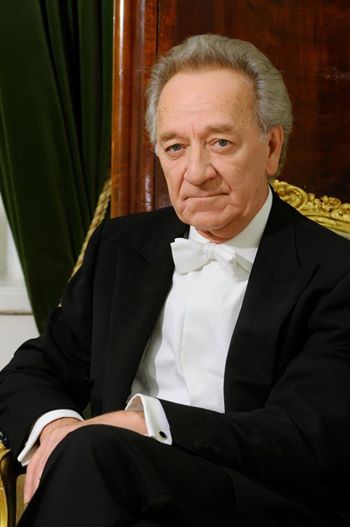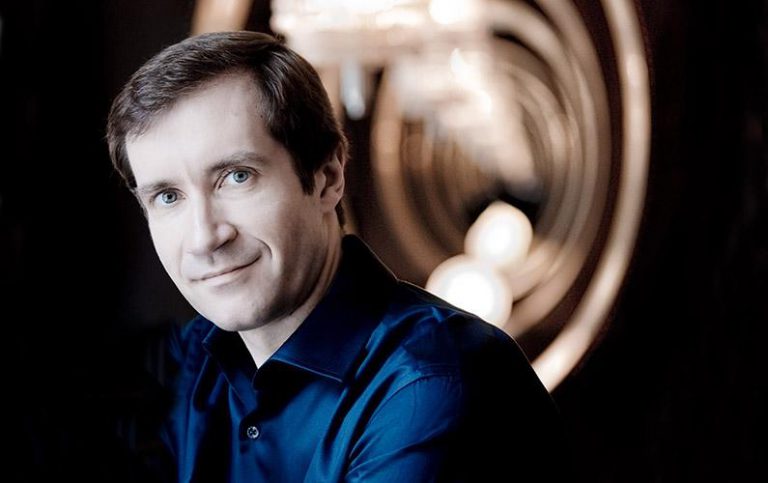St. Petersburg Philharmonic brings rich sound and rough edges to Carnegie Hall

Yuri Temirkanov conducted the St. Petersburg Philharmonic Saturday night at Carnegie Hall.
The logistics of touring are such that orchestra and soloist meet each other temporarily while following independent itineraries, like comets and planets, hoping to illuminate each other. The St. Petersburg Philharmonic and pianist Nikolai Lugansky are currently on tour, and arrived in Carnegie Hall Saturday night where they played with impressive stamina and a touch of disorientation.
The musicians had played four consecutive concerts in different cities through March 2, yet with Yuri Temirkanov conducting, showed little wear. Saturday they played Brahms’ Piano Concerto No. 1 and Shostakovich’s Fifth Symphony—classical staples to be sure, but also, the kind of mutual fit between multiple musicians and orchestras that can be brought from place to place.
Presented by the Cherry Orchard Festival, there was a touch of the utilitarian in the concert. The St. Petersburg group stands out for their warm, smoky orchestral sound. Their rhythms aren’t the sharpest and their attacks aren’t the crispest, but the grain of the strings and the colors of the winds and brass fit together beautifully. It was a pleasure to hear them play Brahms with the sound of mellow passion, a refreshing change from the steely power that most other orchestras bring to the music.

Nikolai Lugansky
The inherent brightness of the piano was an excellent contrast, underlined by Lugansky’s quick attacks. But there were disconnects between soloist and orchestra in the Brahgms concerto, subtle divergences in moods.
The fundamental question seemed to be the balance between inner contemplation, turmoil, and extroversion. That’s a tricky enough interpretive challenge in the concerto, which is grand and eloquent in both public and private ways. Lugansky’s approach was to start each extended statement inside the music, and then find a window through which to burst forth. His playing was exciting, but he often seemed a step ahead of the orchestra. He would then pull back to let them catch up to his thinking, wherein they would push a little too far ahead.
Through the first two movements, each passage of agreement was followed by a slight misstep. But orchestra, soloist, and conductor were clearly all listening to each other, because as the concerto went along, and especially during the Adagio, a consensus gradually came into view. Everyone was in agreement for the Rondo finale, which had a great bounce and swagger. Lugansky settled the crowd with a modest, quiet encore of Mendelssohn’s Songs Without Words, Op. 62, no. 1.
Shostakovich’s Fifth Symphony is not just one of the great modern symphonies, but is a staple of the Petersburg orchestra. Russian musicians draw a substantial Russian audience, some of whom perhaps take their culture for granted, considering the half-dozen cell phones ringing during the quiet opening of the symphony.
As the playing opened and the piece developed, the performance felt just slightly too relaxed— not a problem per se but coming dangerously close to a problem. There were also several ragged moments in the opening movement. But as the tempo and pace of activity picked up in the middle of the opening movement, so too did the orchestra’s energy.
What started as routine became fulfilling. After a nicely noncommittal conclusion to the first movement, the orchestra played the remaining movements with both a swagger and sense of personal anguish, both vital in the composer’s music. The dance rhythms of the Allegretto clearly revived them, and Temirkanov molded an excellent shape in the conquest of the final movement, setting the tension and then opening up a surge of power in the coda.
There was also a nice touch of theater about the performance, of putting on a show. And why not? Shostakovich needed to hide his true thinking, and an ideal way to honor that is to play his music with a consciously insincere rhetoric, a weird expressionless intensity. All that, and the St. Petersburg sound, showed what this orchestra can do at its best.
That best was shown in the encore, an utterly lush “Amoroso” from Prokofiev’s Cinderella.






Posted Mar 09, 2017 at 5:04 pm by Martin Vidnovic
I was very disappointed with Temirkanov’s Carnegie Hall performance of the Shostakovich 5th Symphony on Saturday night, March 4th. Rushed the second theme of the first movement to the point where it lost all poignancy for me. The second movement I don’t remember … unmemorable, so by the time we got to the crucial 3rd movement it was too late. The Finale was dull, as well.
This is one of my all time favorite symphonies, so it’s possible there was some comparing going on, but it just lay there … and I just sat there, unmoved, with my unused tissue in hand that I kept at the ready in anticipation of some waterworks … which never materialized. Very disappointing. Maybe it’s time the St Petersburg band retired that piece due to overuse. Just my opinion, mind you.
The Brahms 1st piano concerto, on the other hand, was wonderful, as was the playing of Nickolai Lugansky. Really great, and I held back tears all through the performance. I mean, I’m not gonna’ blubber …
Thanks,
Marty Vidnovic